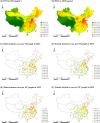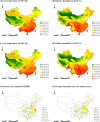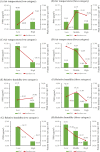Climatic modification effects on the association between PM1 and lung cancer incidence in China
- PMID: 33962607
- PMCID: PMC8106137
- DOI: 10.1186/s12889-021-10912-8
Climatic modification effects on the association between PM1 and lung cancer incidence in China
Abstract
Background: Nationwide studies that examine climatic modification effects on the association between air pollution and health outcome are limited in developing countries. Moreover, few studies focus on PM1 pollution despite its greater health effect.
Objectives: This study aims to determine the modification effects of climatic factors on the associations between PM1 and the incidence rates of lung cancer for males and females in China.
Methods: We conducted a nationwide analysis in 345 Chinese counties (districts) from 2014 to 2015. Mean air temperature and relative humidity over the study period were used as the proxies of climatic conditions. In terms of the multivariable linear regression model, we examined climatic modification effects in the stratified and combined datasets according to the three-category and binary divisions of climatic factors. Moreover, we performed three sensitivity analyses to test the robustness of climatic modification effects.
Results: We found a stronger association between PM1 and the incidence rate of male lung cancer in counties with high levels of air temperature or relative humidity. If there is a 10 μg/m3 shift in PM1, then the change in male incidence rate relative to its mean was higher by 4.39% (95% CI: 2.19, 6.58%) and 8.37% (95% CI: 5.18, 11.56%) in the middle and high temperature groups than in the low temperature group, respectively. The findings of climatic modification effects were robust in the three sensitivity analyses. No significant modification effect was discovered for female incidence rate.
Conclusions: Male residents in high temperature or humidity counties suffer from a larger effect of PM1 on the incidence rate of lung cancer in China. Future research on air pollution-related health impact assessment should consider the differential air pollution effects across different climatic conditions.
Keywords: Climatic factors; Lung cancer incidence; Modification effects; PM1 pollution.
Conflict of interest statement
The authors declare that they have no competing interests.
Figures







Similar articles
-
Do socioeconomic factors modify the effects of PM1 and SO2 on lung cancer incidence in China?Sci Total Environ. 2021 Feb 20;756:143998. doi: 10.1016/j.scitotenv.2020.143998. Epub 2020 Nov 28. Sci Total Environ. 2021. PMID: 33310217
-
Ambient Ozone, PM1 and Female Lung Cancer Incidence in 436 Chinese Counties.Int J Environ Res Public Health. 2021 Oct 2;18(19):10386. doi: 10.3390/ijerph181910386. Int J Environ Res Public Health. 2021. PMID: 34639686 Free PMC article.
-
Air pollution and lung cancer incidence in China: Who are faced with a greater effect?Environ Int. 2019 Nov;132:105077. doi: 10.1016/j.envint.2019.105077. Epub 2019 Aug 12. Environ Int. 2019. PMID: 31415963
-
Air Pollution and Mortality in China.Adv Exp Med Biol. 2017;1017:103-121. doi: 10.1007/978-981-10-5657-4_5. Adv Exp Med Biol. 2017. PMID: 29177960 Review.
-
Comparison of Health Impact of Air Pollution Between China and Other Countries.Adv Exp Med Biol. 2017;1017:215-232. doi: 10.1007/978-981-10-5657-4_9. Adv Exp Med Biol. 2017. PMID: 29177964 Review.
Cited by
-
Identifying the Environmental Determinants of Lung Cancer: A Case Study of Henan, China.Geohealth. 2023 Jun 1;7(6):e2023GH000794. doi: 10.1029/2023GH000794. eCollection 2023 Jun. Geohealth. 2023. PMID: 37275567 Free PMC article.
-
Long-term exposure to particulate matter on cardiovascular and respiratory diseases in low- and middle-income countries: A systematic review and meta-analysis.Front Public Health. 2023 Mar 28;11:1134341. doi: 10.3389/fpubh.2023.1134341. eCollection 2023. Front Public Health. 2023. PMID: 37056647 Free PMC article.
-
Particulate matter air pollution as a cause of lung cancer: epidemiological and experimental evidence.Br J Cancer. 2025 Jun;132(11):986-996. doi: 10.1038/s41416-025-02999-2. Epub 2025 Apr 4. Br J Cancer. 2025. PMID: 40185876 Free PMC article. Review.
-
Prognostic Significance of Tumor Mutation Burden among Patients with Non-small Cell Lung Cancer Who Received Platinum-based Adjuvant Chemotherapy: An Exploratory Study.J Cancer Prev. 2023 Dec 30;28(4):175-184. doi: 10.15430/JCP.2023.28.4.175. J Cancer Prev. 2023. PMID: 38205359 Free PMC article.
-
Exposure-lag response of surface net solar radiation on lung cancer incidence: a global time-series analysis.Transl Lung Cancer Res. 2024 Oct 31;13(10):2524-2537. doi: 10.21037/tlcr-24-125. Epub 2024 Oct 28. Transl Lung Cancer Res. 2024. PMID: 39507019 Free PMC article.
References
Publication types
MeSH terms
Substances
LinkOut - more resources
Full Text Sources
Other Literature Sources
Medical

